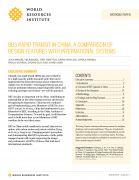Transito Rápido de Autobús en China

Sinopsis
Como dice el reciente libro blanco sobre el transporte de China para el decimotercer plan quinquenal (2016-2020), China debe establecer estándares más altos para el desarrollo del transporte a fin de "realizar el sueño chino del gran rejuvenecimiento de la nación china" (Consejo de Estado Oficina de información 2016). En este espíritu, el documento de trabajo compara los sistemas de BRT en China con los estándares internacionales, con el fin de identificar las áreas que necesitan mejoras. El documento evalúa 30 de los 38 indicadores BRT establecidos en el estándar BRT, empleando análisis de varianza (ANOVA) para comparar las diferencias entre los BRT medios chinos e internacionales, en base a 99 puntos de datos, que representan 59 ciudades (18 en China) y 21 países.
Resumen ejecutivo
Globally, bus rapid transit (BRT) has proved itself to be a high-capacity public transport mode that can be implemented in short time frames and at relatively low capital cost. Its benefits—reducing greenhouse gas and local air pollutant emissions, improving traffic safety, and reducing passenger travel times—are well documented.
BRT can play an important role in China, contributing to sustainability in the urban transport sector and beyond. Recognizing its importance, China has set a national goal of implementing 5,000 kilometers of BRTs by 2020 (MOT 2013a). As of 2015, China had implemented 2,991 kilometers of BRT, according to the China Academy of Transportation Sciences. To reach its goal, it will therefore need to build more than 2,000 kilometers of BRT corridors in the next three years.
BRT in China is still considered a second-class service option, after urban metros and private vehicles (Deng et al. 2013; Zeng 2013). Changing people’s perception and demonstrating that BRT represents a viable public transport mode will require improving the design and performance of BRT in China so that both meet international standards.